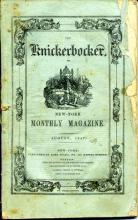
Throughout much of antebellum literature, nature plays the role of arbiter between the physical and the conceptual. That is to say, nature’s patterns and beauty are often utilized as physical illustrations of some of life’s more abstract concepts. Nature serves poets and storytellers alike as an apt analogy for the ideas of love, rage, youth, age, death, and life. Interestingly, although nature’s own intrinsic beauty is heavily discussed in these kinds of literature, its actual significance is primarily only as a vehicle for the portrayal of human issues. In this way, nature becomes an illustrative tool for the conveyance of man’s deepest anxieties. Various exhibitions of nature’s analogical function exist in our featured issues of The Knickerbocker. Here are just a few examples:
At times, nature acts as an apt representation of one's journey through life. Specifically, the transition from youth to old age is represented by a seasonal progression from summer to winter. This kind of progression is further discussed by myself in the editorial note for “The Last Mid-night of summer,” an anonymous poem found in the January 1862 issue of The Knickerbocker.
The December 1844 issue of The Knickerbocker exhibits a comparison between the capricious weather patterns of nature and the volatile human temperament in its featured story “A Night of Terror.” Also, as discussed by my peer Kelsey Whiteside in her editorial note on the piece, we see the unknown author’s use of nature propagate a decidedly gothic style of writing in this story.
In other instances, nature can serve to illustrate the consequences of overstepping social boundaries. T. Barlow’s poem “The Oak and The Apple Tree” in the March 1840 issue of The Knickerbocker demonstrates a paranoia of transient gender roles. As noted by my peer Kelsey Blackman in her editorial note on the piece, the proper role of women is heavily contrasted with the proper role of men in this poem, and mobility between the roles is thoroughly disparaged.
Here and in numerous other examples of antebellum literature exhibited in The Knickerbocker, nature is used as an allegorical vehicle for the demonstration of spiritual, physical, and/or social concepts. As exhibited above, social anxieties can be explored, human behavior can be evaluated, and even the course of a human life can be analogized through the use of the examples provided in the natural world. In this way, humans use nature as a kind of universal constant with which to compare and contrast their own experience of life.